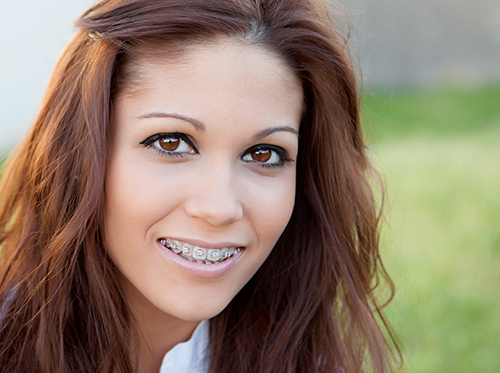June 23rd, 2017

Many people undergo orthodontic treatment during childhood, adolescence, and even into adulthood. Wearing orthodontic appliances like braces is sure to produce a beautiful smile. Though orthodontic treatments at Garai Orthodontic Specialist are designed to accommodate your lifestyle, chances are you will need to make some dietary modifications to prevent damage to your braces and prolong orthodontic treatment.
The First Few Days with Braces
The first few days wearing braces may be the most restrictive. During this time, the adhesive is still curing, which means you will need to consume only soft foods. This probably will not be a problem, however, as your teeth may be tender or sensitive while adjusting to the appliances.
Orthodontic Dietary Restrictions
You can eat most foods normally the way you did without braces. However, some foods can damage orthodontic appliances or cause them to come loose. Examples of foods you will need to avoid include:
- Chewy foods like taffy, chewing gum, beef jerky, and bagels
- Hard foods like peanuts, ice chips, and hard candy
- Crunchy foods like chips, apples, and carrots
How to Continue to Eat the Foods You Love Most
Keep in mind that you may still be able to enjoy some of the foods you love by making certain modifications to the way you eat them. For example, steaming or roasting carrots makes them softer and easier to consume with braces. Similarly, you can remove corn from the cob, or cut up produce like apples and pears to avoid biting into them. Other tips include grinding nuts into your yogurt or dipping hard cookies into milk to soften them. If you must eat hard candies, simply suck on them instead of biting into them.
If you have any question whether a food is safe to eat during your treatment with Garai Orthodontic Specialist, we encourage you to err on the side of caution. Of course, you can always contact our Vienna, VA & Great Falls VA office with any questions you have about your diet and the foods that should be avoided during treatment. By following our dietary instructions and protecting your orthodontic appliances from damage, you will be back to chewing gum in no time.
June 16th, 2017

Clear aligners like Invisalign® have become increasingly popular over the past several years and rightly so. They’re removable, easier to clean than braces, and hardly anyone knows you're wearing them. They are great in treating many cases, but they aren't for everyone.
Below, Dr. Allen Garai & Dr. Karen Tratensek and our team cover some of the instances where clear aligners just aren't the answer:
- If drastic tooth movement is required – Fixed appliances deliver much more significant tooth movement. So if your case is a drastic one, clear aligners may not be the best choice.
- If you need to move molars – Molars have much stronger roots than your other teeth and would require significantly longer to move with clear aligners. A fixed appliance is the best choice in this instance, especially if you have a substantial overbite or underbite that needs to be dealt with.
- If you're the type who often forgets or loses things –If you would forget to wear your aligners for the prescribed amount of time (usually at least 22 hours per day), clear aligners are probably not the best choice for you. Forgetting to wear them can delay treatment and even make it so you need to regress to the previous set of aligners to be able to move forward with treatment. And let's face it, if you're not careful, removable aligners are easy to lose. Losing aligners delays treatment and is expensive since you need to buy replacements to stay on course. Replacing a lost set of aligners usually takes between seven and ten days—a definite setback in treatment.
- If you're looking for the fastest treatment possible – Clear aligners usually can't move teeth as quickly as fixed appliances. So if you're looking for the fastest way to achieve your desired result, clear aligners may not be the best bet.
Feel free to talk with Dr. Allen Garai & Dr. Karen Tratensek about your options regarding braces and clear aligners. We know there are pros and cons to both, so let’s find the option that works best in your life and for your specific needs in terms of treatment. Schedule an appointment at our Vienna, VA & Great Falls VA office today!
June 9th, 2017

At Garai Orthodontic Specialist, we proudly treat adults, teens, and children; no matter what your age, we believe you deserve a great smile. Our warm and welcoming team is known for their for their exceptional orthodontic skills. Dr. Allen Garai & Dr. Karen Tratensek and our talented team have been creating beautiful smiles for years, and today would like to ask: what do you love about your new smile? How has your smile improved your life?
Whether you’ve just come in for an initial orthodontic consultation with Dr. Allen Garai & Dr. Karen Tratensek or your family has been visiting office for years, we would love to hear your thoughts about your treatment. In fact, we encourage you to leave a few words for us below or on our Facebook page!
We look forward to reading your feedback!
June 2nd, 2017

The community health awareness group Oral Health America has reported that 82 percent of adults are unaware of the role that infectious bacteria can play in tooth decay or cavities, and almost three out of five children aged 12 to 19 have tooth decay. Since June is National Smile Month, Dr. Allen Garai & Dr. Karen Tratensek and our team at Garai Orthodontic Specialist thought we’d remind our patients about the importance of good oral hygiene visits between office visits.
To keep your family’s smiles healthy and beautiful for years to come, be sure to:
- Brush at least twice a day with fluoride toothpaste
- Floss every day to clean between your teeth
- Eat a healthy, well-balanced diet
- Reduce your intake of sugary foods and drinks
- Visit Dr. Allen Garai & Dr. Karen Tratensek for scheduled appointments
If you want to know more about healthy home care habits, feel free to ask our team at your next appointment, or ask us on Facebook!






 Website Powered by Sesame 24-7™
Website Powered by Sesame 24-7™